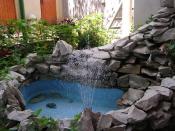Search
Login
Recommended
Types and connection of electric models of heated towel rails
Electric heated towel rails or design radiators serve the host well in the absence of hot water and heating.
Content
- The difference between an electric heated towel rail and water
- Advantages of an electric heated towel rail video
- Disadvantages of an electric heated towel rail
- Liquid-filled electric towel warmers
- Solid Electric Towel Warmers
- Regulation and control
- Construction and design of heated towel rails video
- Heated Towel Colors
The difference between an electric heated towel rail and water
An electric heated towel rail or design radiator, unlike a water heated towel rail, does not need to be connected to water.
This is an independent unit that has its own advantages, since the lack of water (which is usually an aggressive environment due to the presence of oxygen in it) does not cause the destruction of the metal of which the heated towel rail is made.
This allows you to use a more diverse material in the manufacture of heated towel rails.
Naturally, manufacturers have expanded their range of models, although many models are executed both in water and in electric form.
Advantages of an electric heated towel rail
Installation of an electric heated towel rail does not require special installation of an underwater system; this unit can be installed in any place where there is an electric network and an outlet for it.
Such models are easily installed and removed, if necessary, they can be moved to another place and another building.
In case of damage to the electric heated towel rail, no flood will occur, the installation will simply stop working.
Electric heated towel rails can be simply turned on and off, they do not require the installation of any shutoff valves.
Disadvantages of an electric heated towel rail
The main disadvantage of electric heated towel rails is the consumption of electricity.
Depending on the power of the unit, the load increases. Rather high figures in money terms can turn out, in comparison with water, this heat source is much more expensive.
Electric heated towel rails have restrictions on contact with water, some can easily tolerate splashes, and increased humidity is fraught with damage to humans by electric shock.
Those. The electric heated towel rail must not be installed close to the bath or shower.
Liquid-filled electric towel warmers
By design, electric heated towel rails are divided into liquid filled and solid filled.
Models with liquid coolant are usually filled with mineral oil, but some manufacturers also fill with specially treated water without oxygen, which does not cause metal corrosion.
The unit has a heater in the housing; it does not heat up, then transfers heat to the heat carrier, and the heat carrier transfers heat to the surface of the unit.
Solid Electric Towel Warmers
Such aggregates use graphite as filling, to which the heater transfers its heat.
There are models in which film heaters are installed.
There are a lot of options for filling with solid material, as manufacturers develop their own models and at the same time, use different new technologies.
Regulation and control
Electric heated towel rails are available without adjustment, i.e. operate with constant temperature and constant power.
There are models on which regulators are installed, with their help the device turns on and off, the power changes.
Modern advanced manufacturers supply models with control panels; these panels can be mounted on the wall. Such modern heated towel rails are able to set a program for work during the day, or several days.
Naturally, such systems also have protective modes, do not allow the device to overheat, and turn it off in a timely manner.
Modern heated towel rails are equipped with a fan, this speeds up the heating of the room and drying things.
Construction and design of heated towel rails
The task of the heated towel rail is to heat the room and dry the hung things.
Naturally, the larger the radiating surface, the faster the heating and drying.
The next task is to constructively improve the surface for the convenience of placing laundry for drying.
With this in mind, there are a huge number of models and shapes of heated towel rails.
The most common are P and M-shaped stainless steel appliances.
Such devices replace outdated steel pipes, which have been decorating our bathrooms since the Soviet times and play the role of heated towel rails.
Corrosion-proof models do not need to be painted, they are perfectly combined with mixers.
In addition, various advanced models with additional tubes are produced, thereby increasing the usable area and serve as good crossbars for things.
Some models are equipped with shelves and hooks.
Widespread heated towel rails in the form of ladders. Such a model consists of two vertical tubes and several crossbars between them.
Tubes are not only of different diameters, but also of different shapes. For the convenience of placing large items in the form of towels, the crossbars of the pipes are made curved forward.
There are models with two closely spaced vertical tubes, and from them, the tubes horizontally extend in groups on both sides or one side.
Stylish monolithic design radiators are currently popular. This design heats the room well, but is not suitable for drying; special towel holders are released to them.
Heated Towel Colors
Color plays a big role in the projects of the designer, so some manufacturers produce electric heated towel rails or design radiators of various colors.
Usually painted black steel.
A stainless steel appliance is most often not painted, but can polish or impart artificial aging.
It should be noted that the imagination of designers is very great, models are produced using glass, stone, etc.





